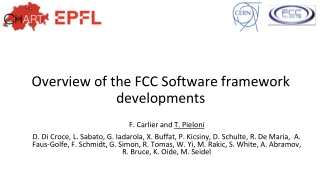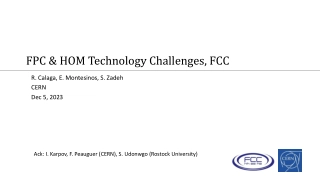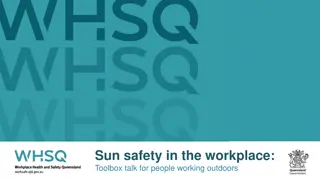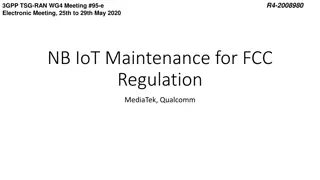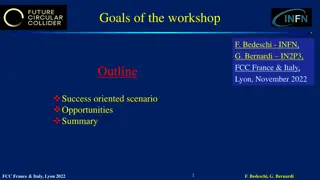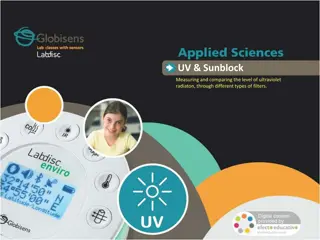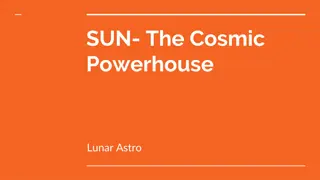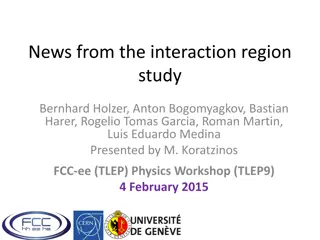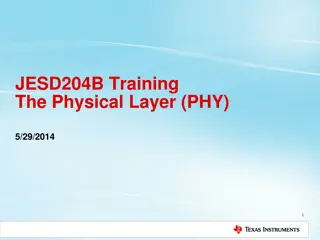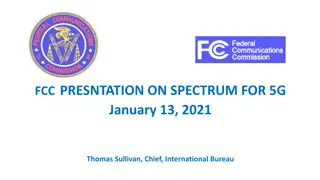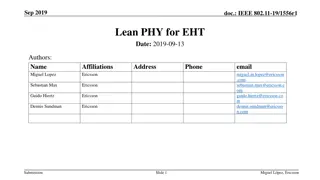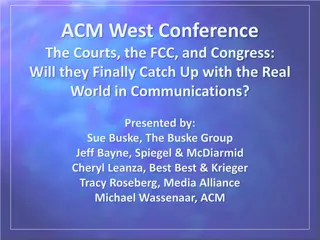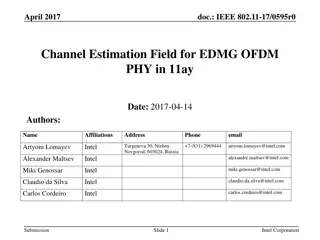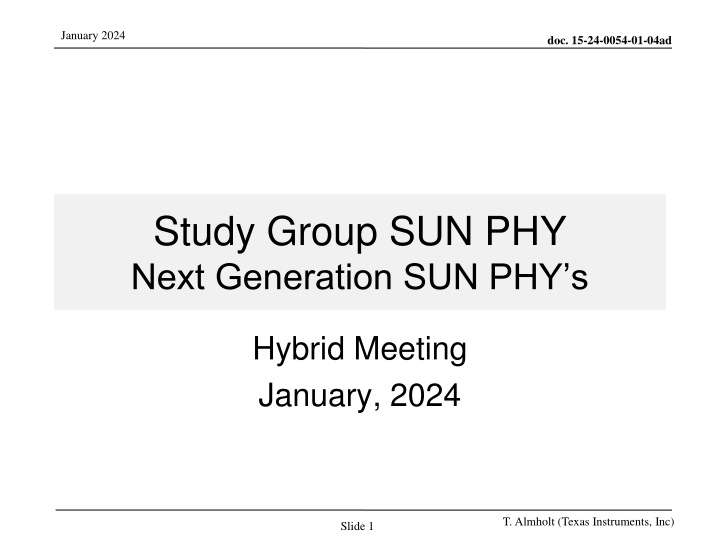
SUN PHY Next Generation: FCC Regulations and Testing Guidelines for OFDM-LR Technology
Explore the FCC regulations and testing methodologies for evaluating OFDM Long Range (OFDM-LR) technology compliance with spread spectrum modulation techniques. Learn about frequency hopping, digital modulation, power testing, and proposed OFDM-LR modes to enable global deployment.
Download Presentation

Please find below an Image/Link to download the presentation.
The content on the website is provided AS IS for your information and personal use only. It may not be sold, licensed, or shared on other websites without obtaining consent from the author. If you encounter any issues during the download, it is possible that the publisher has removed the file from their server.
You are allowed to download the files provided on this website for personal or commercial use, subject to the condition that they are used lawfully. All files are the property of their respective owners.
The content on the website is provided AS IS for your information and personal use only. It may not be sold, licensed, or shared on other websites without obtaining consent from the author.
E N D
Presentation Transcript
January 2024 doc. 15-24-0054-01-04ad Study Group SUN PHY Next Generation SUN PHY s Hybrid Meeting January, 2024 T. Almholt (Texas Instruments, Inc) Slide 1
January 2024 doc. 15-24-0054-01-04ad Agenda FCC regulations discussion on how to evaluate that OFDM-LR with its sparse sub channel hopping actually is compliant with spread spectrum modulation measurement techniques defined in the FCC. T. Almholt (Texas Instruments, Inc) Slide2
January 2024 doc. 15-24-0054-01-04ad FCC rule interpretation prepared for IEEE meeting (please always refer to official documents) Operation under the provisions of this Section is limited to frequency hopping and digitally modulated intentional radiators that comply with the following provisions: Operating in the 902 928 MHz band: 1. Fixed frequency < 0dBm 2. 20dB Bandwidth < 250kHz > 50 hopping frequencies, dwell time 400ms over a 20s period Peak conduction power < 1W (30dBm) 3. 20dB Bandwidth > 250kHz > 25 hopping frequencies, dwell time 400ms over a 10s period Peak conduction power < 125mW (21dBm) 4. Systems using digital modulation techniques may operate in the 902 928 MHz, 2400 2483.5 MHz, and 5725 5850 MHz bands. The minimum 6 dB bandwidth shall be at least 500 kHz. Peak conduction power < 1W (30dBm) T. Almholt (Texas Instruments, Inc)
January 2024 doc. 15-24-0054-01-04ad FCC 15.247 rules are public https://www.ecfr.gov/current/title-47/chapter-I/subchapter-A/part- 15/subpart-C/subject-group-ECFR2f2e5828339709e/section-15.247 T. Almholt (Texas Instruments, Inc) Slide4
January 2024 doc. 15-24-0054-01-04ad How to test for TX power Test methods are defined in ANSI C63, but which one? There is 3 more pages this is incredibly comprehensive and all of the documents can be found on IEEE (Mentor) So the FCC made a guide https://apps.fcc.gov/kdb/GetAttachment.html?id=tylb5MMggvhIlVMK 75RrRQ%3D%3D&desc=558074%20D01%2015.247%20Meas%20G uidance%20v05r02&tracking_number=21124 And this guides calls for ANSI 63.10 T. Almholt (Texas Instruments, Inc) Slide5
January 2024 doc. 15-24-0054-01-04ad There are 5 different PSD testing methods, we have found AVGPSK-1A to provide best results for OFDM Long Range Link to document https://ieeexplore.ieee.org/document/9340083 T. Almholt (Texas Instruments, Inc) Slide6
January 2024 doc. 15-24-0054-01-04ad Proposed OFDM-LR modes Using SUN-OFDM as a baseline, the proposed OFDM-LR also includes a significant number of options to enable world wide deployment. In the follow pages we are showing the FCC PSD measurements on Symbol duration = 60us, Option 2, DSSS=6 => 550KHz wide signal with 1.4kbps effective data rate Sensitivity on HW was measured at -124dBm # Active Tones O1 (1 MHz) Data Rates (DSSS=2/4/6/8 ) # Active Tones O2 (500 kHz) Data Rates (DSSS=2/4/6/ 8) # Active Tones O3 (250 kHz) Data Rates (DSSS=2/4/6/ 8) # Active Tones O4 (125 kHz) Data Rates (DSSS=2/4/6/ 8) Symbol Duration Channel Spacing 2 / 1 / 0.7 / 0.5 2 / 1 / 0.7 / 0.5 2 / 1 / 0.7 / 0.5 2 / 1 / 0.7 / 0.5 120 us 10.416 kHz 104 52 26 14 52 4 / 2 / 1.4 / 1 12 4 / 2 / 1.4 / 1 6 4 / 2 / 1.4 / 1 60 us 20.833 kHz 26 4 / 2 / 1.4 / 1 30 us 41.666 kHz 26 8 / 4 / 3 / 2 12 8 / 4 / 3 / 2 6 8 / 4 / 3 / 2 - - 15 us 83.333 kHz 12 17 / 8 / 6 / 4 6 17 / 8 / 6 / 4 - - - - T. Almholt (Texas Instruments, Inc) Slide7
January 2024 doc. 15-24-0054-01-04ad There are 5 different PSD testing methods, we have found AVGPSK-1A to provide best results Measured at 27dBm total power, so at -124dBm sensitivity this will result in a link budget of 151dB T. Almholt (Texas Instruments, Inc) Slide8
January 2024 doc. 15-24-0054-01-04ad PSD measurement including the preamble/sync word Measured at 27dBm total power T. Almholt (Texas Instruments, Inc) Slide9

